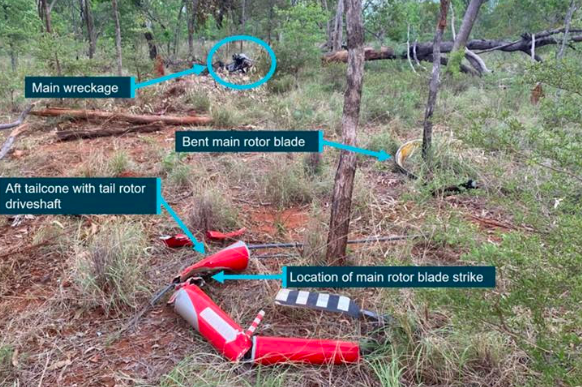VFR Helicopter Pilot Fatality, Flying After Last Light

VFR (visual flight rules) helicopter pilot departed after last light prior to collision with terrain.
The VFR pilot of an R22 helicopter that collided with terrain south of Katherine in December 2023 had taken off after last light without the qualifications to fly at night. Also, the helicopter was not equipped to be flown at night, an ATSB (Australian Transport Safety Bureau) final report details.
A search was initiated at 8:15 pm on the evening of 7 December 2023 after the VFR pilot did not arrive as planned at Gorrie Station, having departed nearby Bloodwood Station 45 minutes earlier.
The wreckage of the destroyed aircraft was subsequently discovered about 6 km away from Gorrie. The pilot was fatally injured.
The ATSB investigation report details that despite being offered a place to stay overnight at Bloodwood Station, the pilot had taken off after last light to return to their own property.
The pilot did not hold a night visual flight rules (VFR) rating but had reportedly completed some night flying training and had arrived home after last light on previous occasions.
“Pilots qualified to only operate under day visual flight rules are at risk of spatial disorientation and loss of control of their aircraft when they operate – intentionally or otherwise – in night conditions, where little to no useable external visual cues can be present,” ATSB Director Transport Safety Stuart Macleod said.
“The visual flight rules require pilots to only operate under daylight conditions, and to plan to land 10 minutes before last light, which provides a reliable method for ensuring there are sufficient external visual references available to safely operate.”
The ATSB report notes the accident helicopter was not equipped for night flight. Notably, it did not have an artificial horizon.
“Without the minimum instruments and training, it was unlikely that the pilot would have been able to orientate the helicopter without external visual references,” Mr. Macleod said.
“It is likely that during the return home flight, the helicopter entered a smoke plume associated with bushfires under dark night conditions, and the pilot became spatially disorientated, resulting in a collision with terrain, uncontrolled, at a high speed.”
The ATSB’s avoidable accidents publication on visual flight at night accidents and CASA’s advisory circular for the Night VFR rating (AC 61-05 v1.1) provide further discussion of the risks associated with night VFR flight and the requirements for operating VFR at night.
Read the ATSB report: VFR into smoke on a dark night and collision with terrain involving Robinson R22, VH-DLD, 112 km south-south-east of Tindal Aerodrome, Northern Territory on 7 December 2023.



